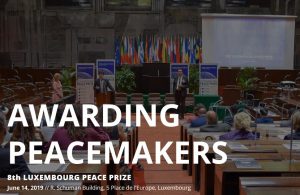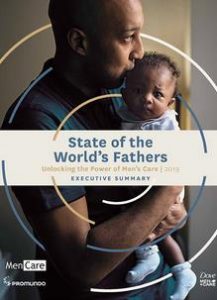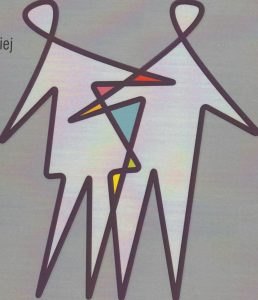Each year, since 2012, the Schengen Peace Foundation and the World Peace Forum award the Luxembourg Peace Prize, an award that “honors the outstanding in the field of peace”. The categories of the Luxembourg Peace Prize and their celebration “amplify the aims and goals of the World Peace Forum”. This year, the award for “outstanding peace organization” was given to Promundo.
The prize for “outstanding peace activist” was given to Masami Saionji and Hiroo Saionji of the Goi Peace Foundation and May Peace Prevail On Earth International, based in Japan. Thich Nhat Hanh received the award for “outstanding inner peace”.
Since its founding in Brazil in 1997, Promundo has worked in collaboration with partners to advance gender equality and prevent violence in over 40 countries around the world through research and evaluation, targeted advocacy efforts, and evidence-based educational and community-wide program implementation.
The research model and its links to implementation and innovation are a main part of the reason why Promundo received the prize. The prize statement specifically mentions “high-impact research”. Cf https://luxembourgpeaceprize.org/laureates/outstanding-peace-organization/2019-promundo/
The new research is also used in the recent State of the world’s fathers report (cf https://genderjustice.org.za/publication/state-of-the-worlds-fathers-2019-executive-summary/), which has drawn attention from media including The New York Times (https://www.nytimes.com/2019/06/07/us/parents-fathers-role.html )
An important part of this research model was developed in Norway. Here is the background. And some ideas, how to follow up. 7 points, in all.
 (detail of cover of Brandth and Kvande, editors: Fedrekvoten [The father quota], 2013)
(detail of cover of Brandth and Kvande, editors: Fedrekvoten [The father quota], 2013)
1
A main part of the Promundo research effort started from a new type of gender equality survey made in Norway in 2007 in a project and survey called “Gender equality and quality of life”. The survey included much more detail on gender equality than previous studies, including more perspective on men as well as women, more focus on gender equality not just in opinions but also practices, household care and work divisions, and well-being, health, conflict and violence.
2
The Promundo team developed the Norway survey framework into a more relevant and applied version applicable in the global south, focusing on violence and health issues, and expanding the practical experience questions. In the first 6-country survey (2009-11), about 60 percent of the questions were taken from the Norwegian survey. The Promundo survey was called IMAGES – International Men and Gender Equality Survey. Later, as Promundo and local partners have adapted the survey in new contexts, now more than 40 countries, many of those core questions have continued to be used. And the logic of gender equality being related to quality of life continues to be a key conceptual framework for the studies.
3
The survey design was further developed by the Promundo team in a variety of contexts and collaborations, including cooperation with researchers at the Centre for gender research, University of Oslo. In some respects, it goes far beyond the original Norwegian project, although main questions and an important part of the framework remained the same.
4
The Promundo development mainly concerned actions – more than structures. The original Norwegian model had more emphasis on mapping structural factors hindering or helping gender equality. Later, an independent development of the structural part of the design was made in a Poland-Norway study (2015). Several books and papers have been published from this project (called GEQ – Gender equality and quality of life).
The Poland-Norway study includes a “European blueprint” for a wider European project, combining a developed survey questionnaire with interviews and other data. See http://www.geq.socjologia.uj.edu.pl/en_GB/start?p_p_id=56_INSTANCE_ZGJFS82ydNo6&p_p_lifecycle=0&p_p_state=normal&p_p_mode=view&p_p_col_id=column-2&p_p_col_count=3&groupId=32447484&articleId=136474060 – The Promundo survey developments gradually also included structural factors.
5
However, a comparison of these partly independent developments of the same research model remains to be made. The original gender equality model focused on a number of broad factors to be investigated regarding the “state of gender in/equality” – how to measure this as an independent dimension, in society. These included gender equality in childhood and youth, in working life, public sphere, family and household, etc. The presumed factors were designated mainly as “structural” but included cultural variables also. The design had a social-psychological dimension.
6
Why has the research model been a success? It goes into a not so well known area, men and gender equality, combining action questions with structure questions and cultural questions. It is focused on important issues like health, caring, conflict and violence. It s not a “cover all” but offers a more detailed map than other research designs. Weak spots can be reduced by combining surveys with other methods.
A main reason for the success, in my view, is the combination of action and structure aspects. This means that trends and actions among men (and women) can be analyzed with more nuance and precision, regarding structural factors. You get more information on specific themes like violence, especially in the IMAGES version, and also tools to adjust for different social and cultural context, including five main dimensions of gender equality and (in less detail) other discrimination experiences. This makes for a powerful tool. It is a bit like a “meme”. Once you have this new mapping, you don’t want to be without it. In principle, investigation can be focused and targeted, and remain balanced, un-prejudiced.
7
Analyzing the total evidence, both the new European studies and the new global studies, is a main issue now. It needs to be done. Through our center at the University of Oslo, I have cooperated with Promundo in order to get this issue into the prioritized European research agenda. So far, without funding. I hope this will change, now.
There is no doubt whatsoever that this research effort on gender, men, women, violence and conflict, health and well-being – is of great importance not just in itself, but also in relation to other top priority research areas. How to reduce social discrimination. How to resolve burning questions of climate change. How to engage men and boys as well as girls and women in positive gender equality change.
Now more than ever, with so much interest in the topic of engaging boys and men by donors, governments and academics, the IMAGES dataset, together with the European dataset, is an unprecedented resource for analyzing these issues, and considering how to bring other topics into new surveys, and begin to carry out the survey again in the same countries 10 or 15 years later to assess change. Furthermore, given that Gates Foundation supported Promundo to unify and clean up the global dataset, Promundo and the University of Oslo are well-placed to carry out this analysis – building theory, identifying gaps and opportunities, and making IMAGES and European tools, questionnaires and interview guides even more available to interested researchers.




